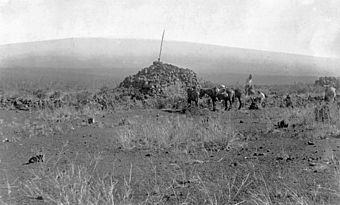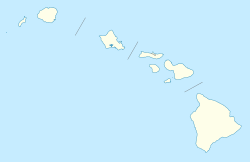Ahu A ʻUmi Heiau facts for kids
Quick facts for kids |
|
|
Ahua A ʻUmi Heiau
|
|

A portion of the site, circa 1890
|
|
| Location | North Kona |
|---|---|
| Area | 5 acres (2.0 ha) |
| Built | 1449-1500 |
| Architectural style | Ancient Hawaiian |
| NRHP reference No. | 74000343 |
| Added to NRHP | August 13, 1974 |
Ahu A ʻUmi Heiau is an ancient Hawaiian sacred site. Its name means "shrine at the temple of ʻUmi" in the Hawaiian language. It can also be called "mound of ʻUmi."
This special place was built for a powerful chief named ʻUmi-a-Liloa, often known as ʻUmi. He ruled the island of Hawaiʻi in the early 1500s. Chief ʻUmi even moved his government's main center to this spot from the Waipiʻo Valley. The main center of power stayed in the Kona District for many years.
Ahu A ʻUmi Heiau was also a hiding place for Chief Keawenuiaʻumi, ʻUmi's son. He hid here to escape a strong chief named Kalepuni, who tried to take over his rule.
What is Ahu A ʻUmi Heiau?
This site is a large area surrounded by stone piles called cairns. Some of these stone piles are as tall as four meters (about 13 feet) and seven meters (about 23 feet) wide.
It's quite unusual that this sacred site was built so far inland. It sits on a high, dry area between two large volcanoes, Mauna Loa and Hualālai.
History of the Site
In the 1800s, parts of the site were used as a corral for animals. However, many original parts of the heiau are still there today.
A trail called the Judd Trail was started in 1849. It was meant to be a direct path between Kailua and Hilo. However, the trail was never finished. A volcanic eruption from Mauna Loa in 1859 covered part of the planned route.
Today, this area is not easy to reach because it is very high up, over 5,000 feet (1,500 m) (about 1,500 meters) above sea level. In ancient times, there were likely many trails named after King ʻUmi that led to this area. Some people have suggested restoring these old trails to create a new trail system on Mauna Loa.
Protecting a Historic Place
Ahu A ʻUmi Heiau is listed on Hawaii's state register of historic places. It was also added to the National Register of Historic Places on August 13, 1974. This means it is recognized as an important historical site in the United States.
The site is located in a traditional Hawaiian land division called an ahupuaʻa, specifically in the area known as Keauhou 2.
Modern studies suggest that this complex site might have been used to track the movements of stars and planets. This means it could have been an ancient astronomical observatory.


